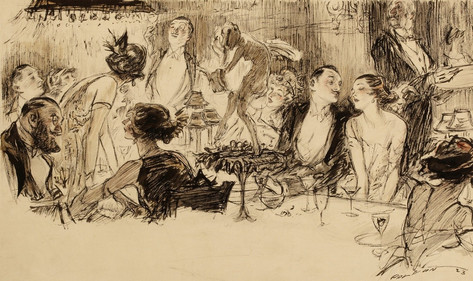Henry Patrick Raleigh - Gifted Gallery
- Lilium

- Jun 29, 2022
- 3 min read

Henry Patrick Raleigh, born 1880, was an American illustrator who flourished during the Golden Age of Illustration, his drawings of society life defined the era. He was sought after by the most popular authors and publications. During his success, he was one of the highest-paid illustrators in the country.
Raleigh was born in Portland, Oregon. He began working at the age of 9 selling newspapers to support his mother and sisters. By the age of 12 he dropped out of school and found work on the docks of San Francisco for a coffee importer. Taking a liking to the budding artist, Raleigh’s boss offered to pay his tuition at renowned San Francisco art school, the Hopkins Academy. After three years, Raleigh graduated from Hopkins. At just 17 he landed a job with the San Francisco Bulletin newspaper as a newspaper sketch artist on the west coast back in the era when artists were needed to quickly record news events. By the age of 19, he was working for the San Francisco Examiner as one of their highest-paid artists.

As a result of that experience, he was extremely prolific, creating about 20,000 illustrations in his career, at a rate of about 800 per year, almost three drawings per day. He had an excellent visual memory and worked almost entirely without models or photo reference.
The San Francisco Examiner happened to be American publisher William Randolph Hearst’s favourite newspaper. Discovering Raleigh’s work in the pages of the Examiner, Hearst asked him to relocate to work for The New York Journal. In just nine months of moving to New York and working for the Journal, Raleigh was offered a position at their rival paper, The New York World. With a large salary increase, his new role only required him to work three days a week. Assigned to illustrate Special Features, he covered the high society events of New York.
His short working weeks allowed him to take on commissions from magazines. Vanity Fair, Harper’s Bazar, Collier’s, and Saturday Evening Post were among some of his early assignments. With his popularity still growing, at just 30 years of age, Raleigh was making more money than he could have dreamed of. In 1914 he was chosen by Collier’s to create illustrations for a five-part serialized story of “Bealby” by H. G. Wells. Thanks to its success, Raleigh became one of the most sought-after illustrators in America.
By his 25th year working professionally, he had published over 20,000 illustrations. For three decades his average income was well over $100,000 per year, even during the depression. Over the years Raleigh illustrated over 500 Saturday Evening Post stories and moved into the world of book illustration. He illustrated books for F. Scott Fitzgerald, Agatha Christie, Stephen Vincent Benet, William Faulkner, Sinclair Lewis, and Somerset Maugham. Fitzgerald wrote him a letter saying, “Honestly, I think they’re the best illustrations I’ve ever seen!”
Raleigh spent his money freely, he gave away thousands of dollars to friends, travelled, maintained a yacht, owned a mansion and kept a large studio in downtown Manhattan. At his peak, Raleigh was able to indulge in a lifestyle of regular trips abroad with family and friends. He found that travelling to exotic locations was the balance he needed. It helped restore his passion for illustration.

By the 1940s, his work had fallen out of step with art directors at the major magazines like the Saturday Evening Post. The glamorous life evaporated. In failing health, without having saved money for his retirement, and without steady work, he took his own life.
Raleigh is now remembered for his prolific illustrations. He has received many recognitions, among them are the Shaw Prize for Illustration at the Salmagundi Club in 1916, the Gold Medal for Advertising Art in America in 1926 and a place in the Society of Illustrators Hall of Fame in 1982. You can find out more about Henry Patrick Raleigh on his website set up by his grandson.
"Raleigh’s seemingly effortless approach to illustration showcases excellent draftsmanship with a great understanding of composition. Well-placed lines are used to guide the viewer to the intended focal points. A very beautiful and noticeable aspect of Raleigh’s style is his combining of tight, carefully observed, drawing with loose, uncontrolled, scribbles. This is not a sign of laziness nor superfluous flourishes." In an interview, Raleigh said of his work:
“The most beautiful picture is one which the observer is left free to complete for himself. The illustrator should be able to select the essential elements in any subject which will convey to the layman the entire scene in the simplest and most direct way, avoiding mere details which tend to cause either monotony or confusion.”
Reading Recommendations & Content Considerations

The Confident Illustrator
Christopher Raleigh & Manuel Auad


































































































































Comentarios